
1 minute read
Dredging Impact on Atlantic Sturgeon Migration
40-75% INCREASE IN AVAILABLE DREDGE TIME
Many states have implemented time-of-year restriction windows on federal dredging projects to avoid potential dredge-related risks to sensitive biological resources or habitats. Currently, states along the East Coast have established environmental windows for fish that migrate from salt water to spawn in fresh water. This includes the federally endangered Atlantic Sturgeon (ATS). Since 2012, several studies have documented that ATS spawning occurs during both spring and fall within distinct river systems. The discovery of multiple spawning seasons has resulted in modifications to existing ATS population-monitoring strategies and has raised concerns with state and federal agencies with respect to expanding protection of migratory fish into the fall months. Although dredging is listed as a threat to ATS recovery, there are limited data on the dredging effects and on ATS movement near a dredge. The Corps has conducted a novel field study using acoustic telemetry to determine how adult ATS, migrating to spawning habitats, move around an active dredge. Using fine spatial-scale data to characterize ATS movements around an operating dredge is critical to determining whether environmental windows are necessary to protect spawning ATS from dredging activities.

PROBLEM: There is concern about the potential impacts of dredging activities — excavation, transit, disposal and noise — on the endangered Atlantic Sturgeon. Prior to conducting acoustic telemetry field studies, there were limited data on fish movement and feeding behavior near an active dredge, yet restrictions remained.
SOLUTION: Corps researchers studied the movement patterns of more than 100 tagged sturgeon while they were migrating to spawning grounds in Virginia’s James River with an active cutterhead dredge in their migration path. Fine-scale acoustic telemetry indicated that adult and sub-adult sturgeon preferred to stay in the navigation channel where the dredge was working. They also moved past the active dredge unharmed and successfully reached their spawning habitat farther upstream.
IMPACT: This study provided scientific evidence that cutterhead dredging does not affect ATS spawning migrations. Removing the timing restriction based on this evidence would increase the available time for dredging by 40-75 percent. This increase would enable more time for active dredging, more competitive bidding, decreased operational costs and increased operational flexibility.











